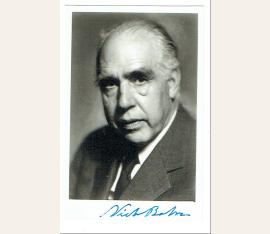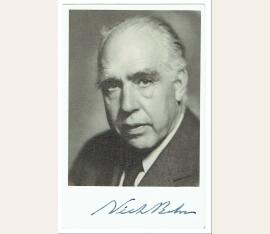physicist and Nobel Laureate (1885-1962). Signed photograph. no place; no date. 3.25 x 5 inch.
$ 3,206 / 3.000 €
(83488)
Rare matte black and white photograph of Bohr in a head and shoulders pose with white border. Signed in blue ink, "Niels Bohr." Niels Bohr (1885-1962) was a Danish physicist. He received the Nobel Prize for Physics in 1922 for his work applying the quantum concept to the problem of atomic and molecular structure. Forced to flee Denmark after the Nazi occupation in 1943, he settled in Sweden briefly before moving to London. Bohr worked at Los Alamos on the Manhattan Project under the pseudonym Nicholas Baker and spent the next two years flying between London, Washington and Los Alamos.
He recognized early on how their work would complicate international relations and thus, spent the rest of his life advocating for passive applications of atomic energy..
dän. Physiker, Nobelpreisträger 1922(1885-1962). Portraitphotographie mit eigenh. Unterschrift auf der Bildseite. ohne Ort und Datum. 120 : 75 mm.
$ 2,778 / 2.600 €
(87919)
Brustbild, den Körper leicht zur Seite gewandt. Sehr selten.
sold
Ms. Brief mit eigenh. U.
Autograph ist nicht mehr verfügbar
Letter to the publisher W. Keiper in Berlin. In part (translated): “I have your friendly letter asking if I was satisfied with the proposed dedication in your edition of Planck's recollections. It is hard for me to answer the question posed, because it seems to me that a dedication to certain organizations or persons hardly projects the paramount importance of Planck's life work to the science of our time. Anyway, I might like to know, on the one hand, if you have already received from the Nobel Foundation and other named persons the approval of the dedication and it would therefore be associated with difficulties…On the other hand, after the eight names among the many [Nobel] award-winners for Physics selected, you omit entirely others such as Compton, Dirac, Fermi, Franck, Pauli, Rabi, Stern, from whom so many significant contributions to the Planck quantum theory have come.” Intersecting folds, a few significant stains affecting the overall appearance, and punch holes to the left edge, otherwise fine condition. Fabulous content associating several of the most influential figures in the development of quantum theory.
Brief m. e. U.
Autograph ist nicht mehr verfügbar
Niels Bohr (1885-1962), Physiker, Nobelpreisträger; einer der bedeutendsten Atomphysiker des 20. Jahrhunderts, schuf mit seinem Atommodell die Grundlage der modernen Atomphysik. Brief m. e. U., Kopenhagen, 16. Juli 1920, 1 ½ Seiten gr.-4°. Gelocht; das 2. Blatt mit kleinem Faltenschaden. An den Physiker Rudolf Ladenburg „über die Konstitution der Atome der Elemente“: „[…] Die Schwierigkeiten des Problems liegen besonders in der rationellen Verwertung der verschiedenen vorgeschlagenen Elektronkonfigurationen auf die Erklärung der chemischen Eigenschaften der betreffenden Elemente […] Ausser der Schwierigkeiten, die […] die Annahme von Elektronringe mit sich bringt für eine Erklärung der Eigenschaften der Krystalle, Bandenspektra, Ionisationspotentiale u.s.w., scheint es auch, dass eine Annahme von Ringe schon wegen der ungenügende Stabilität zu verlassen ist, und dass wir gezwungen sind mit viel verwickelter Bewegungen der Elektronen im Atom zu rechnen […] Was Ihre spezielle Frage nach der Konstitution der Atome der Edelgase anbelangt, glaube ich, dass derartige Betrachtungen wie die Kossel’schen vielleicht nicht so schwerwiegende Argumente beibringen, wie man beim ersten Blick geneigt wäre zu glauben […]“ – Im folgenden Jahr lieferte Bohr seine Erklärung für den Aufbau des periodischen Systems der Elemente, indem er die Atomhülle als aus Elektronenschalen aufgebaut darstellte. – So inhaltsreiche Briefe Bohrs sind äußerst selten.
Eigenhändiger Brief mit Unterschrift.
Autograph ist nicht mehr verfügbar


